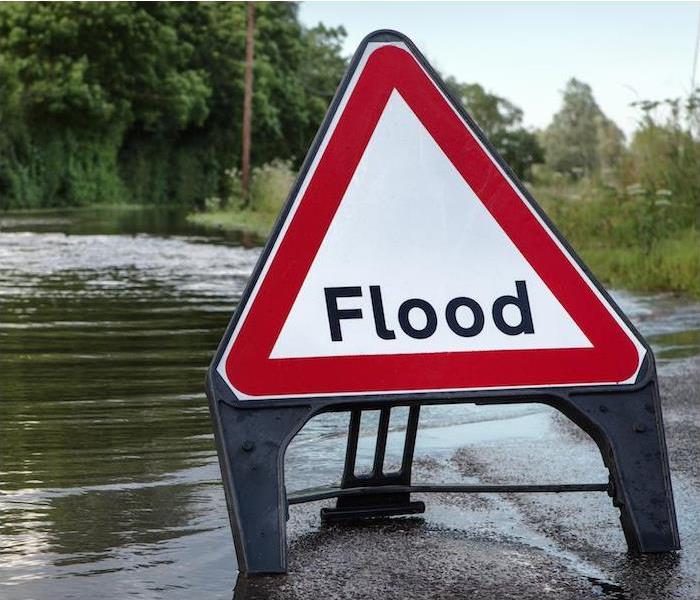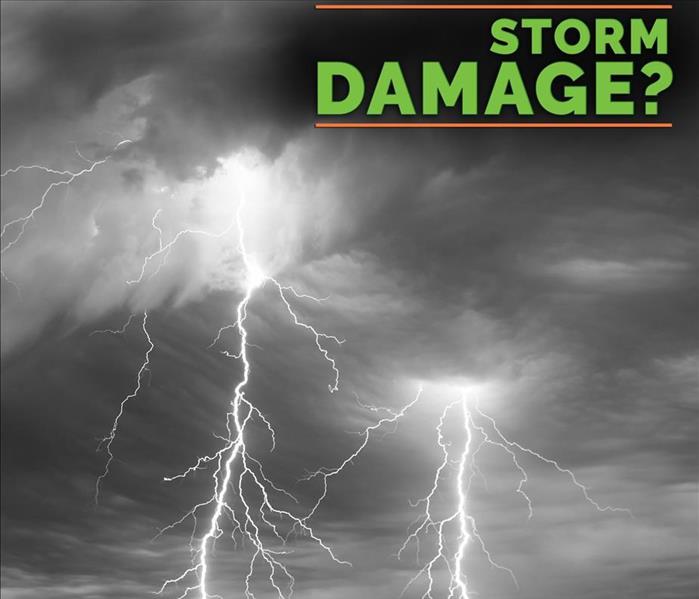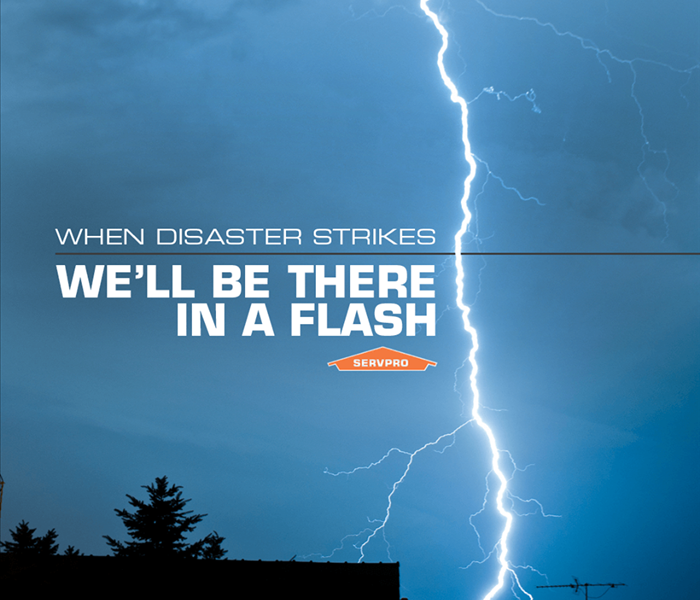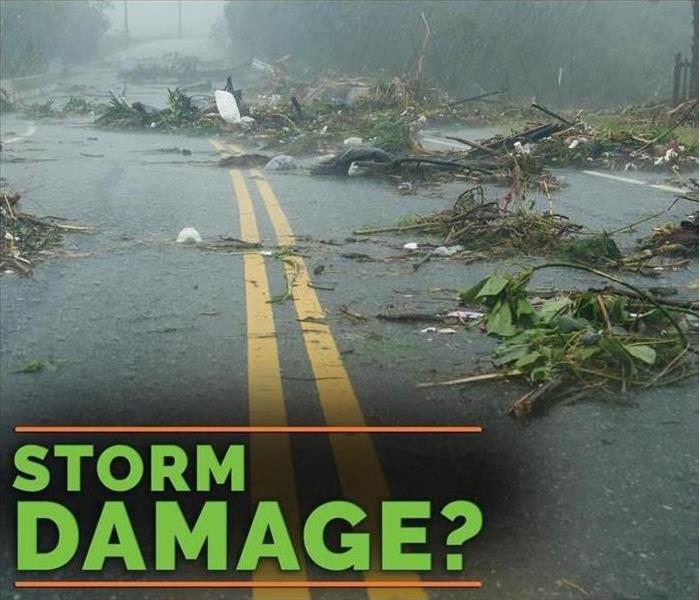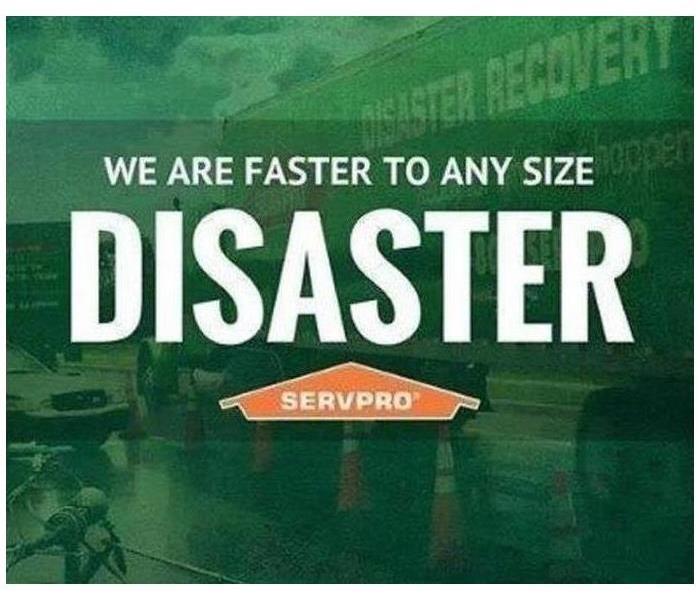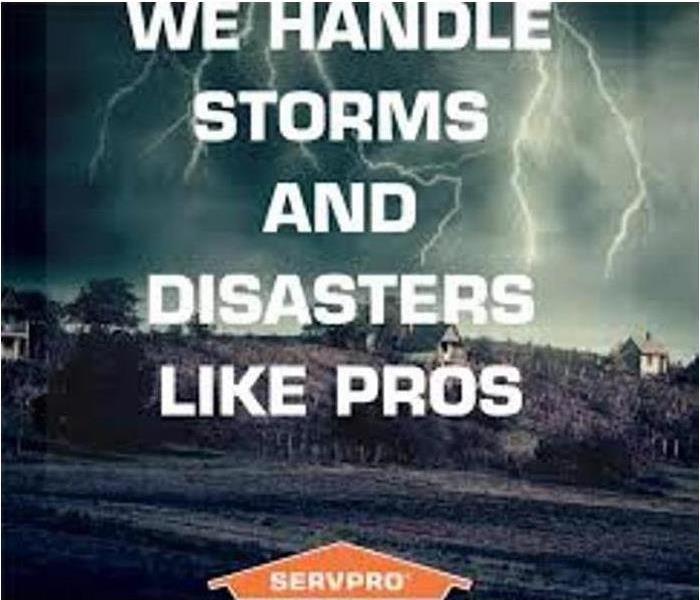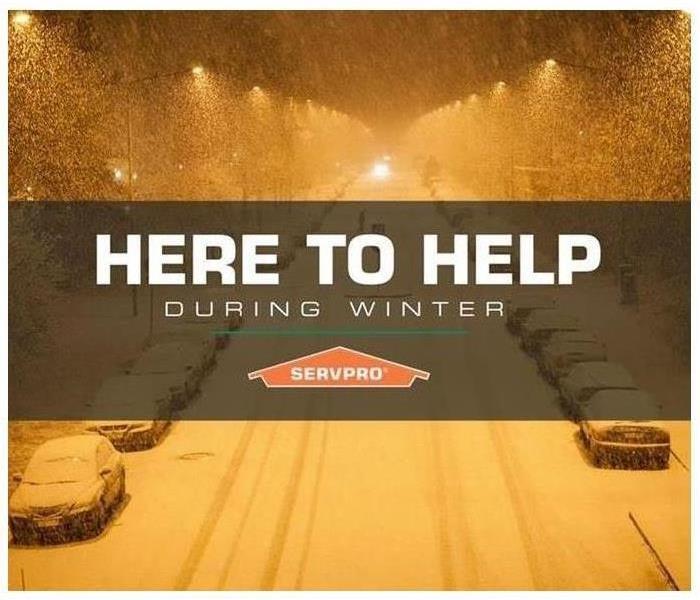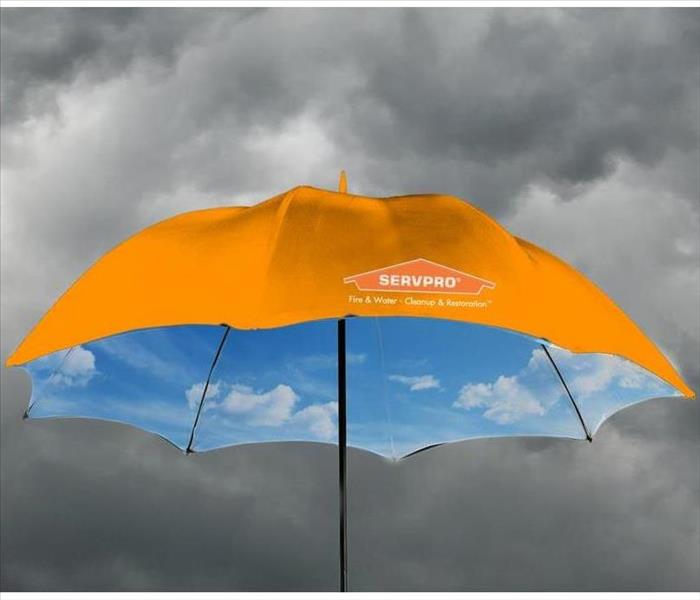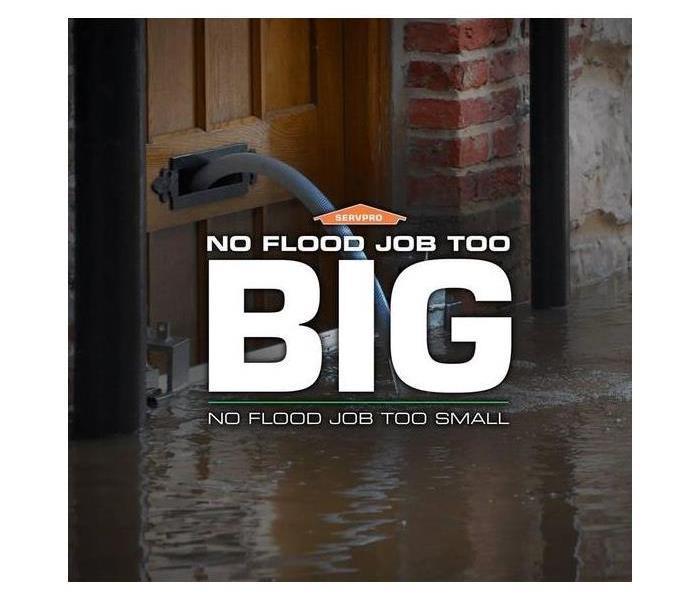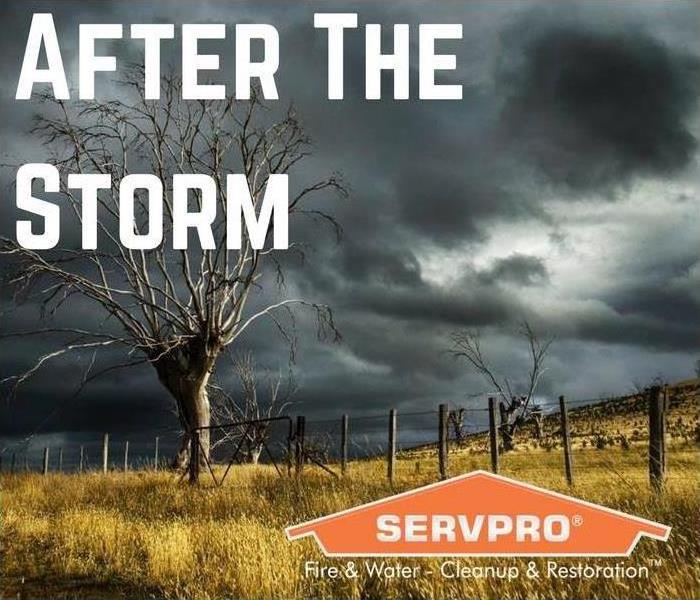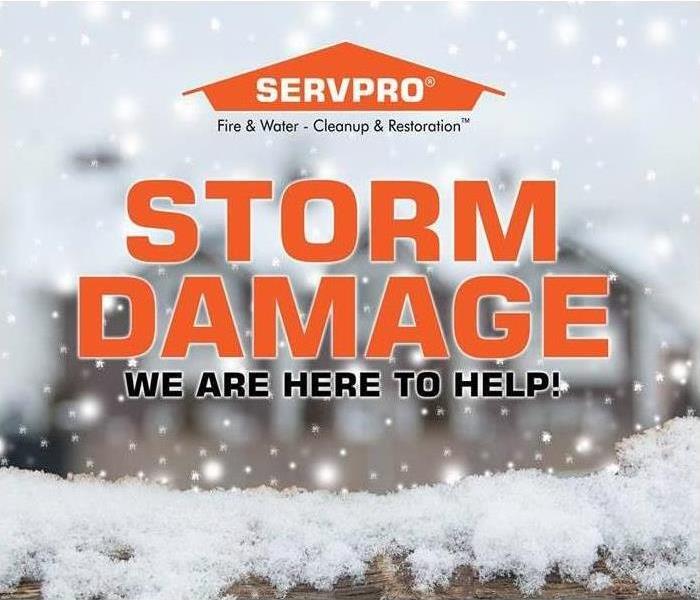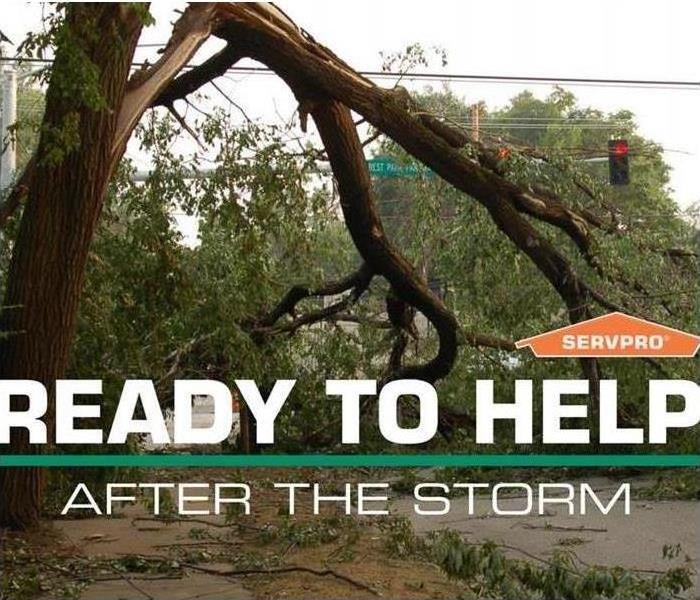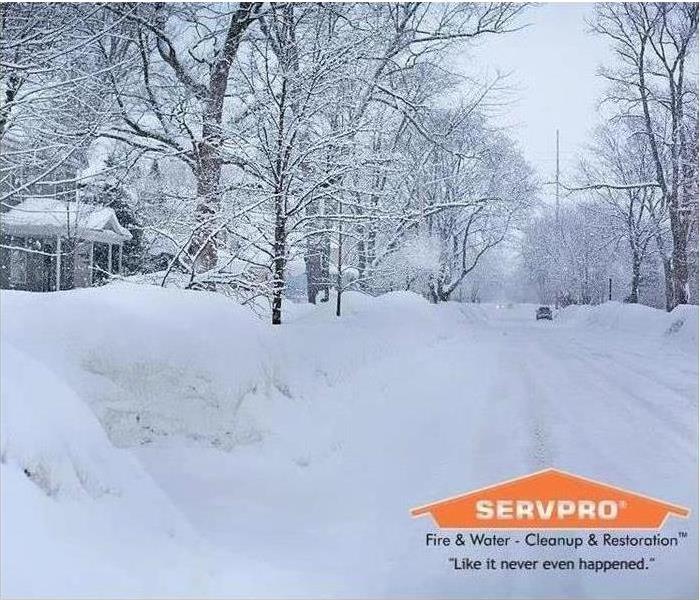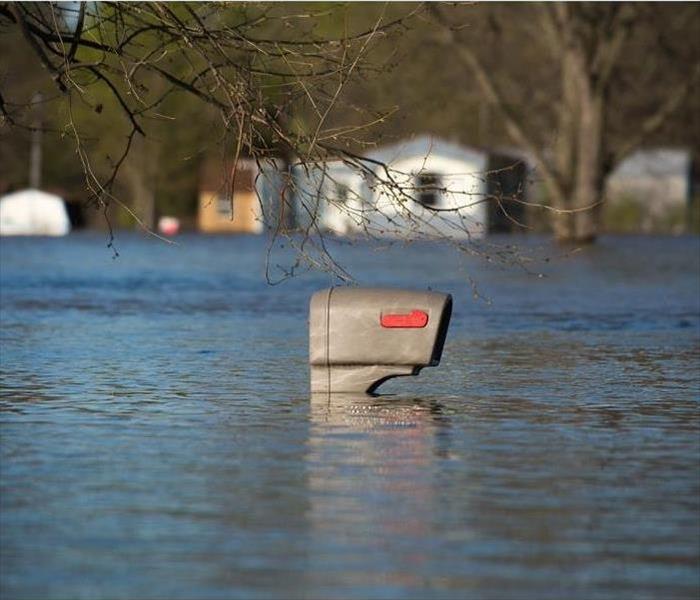Archived Storm Damage Blog Posts
Stay Safe with Understanding
9/12/2022 (Permalink)
When the weather gets scary, information and plans can get easily confused. There are around 42 different kinds of weather alerts from seven different categories. That is a lot to sort through when you are trying to protect your family.
When you have an understanding of different weather advisories, it means you are able to get to safety faster. It also means you can take proactive action now in order to protect your property and prevent damages later.
An overall knowledge of several kinds of weather events is good, but it is crucial to understand what the alerts we will most often see in Michigan mean.
How Alerts Are IssuedHave you ever wondered where weather alerts come from? Forecasts are just predictions, so how is a storm’s location, severity and length watched? There are a few answers to those questions.
You probably already know the name the National Weather Service, but were you aware they create weather forecasts and issue any warnings needed? There are six different regional offices and more than 100 forecasting offices around the nation, which means our forecast is localized and accurate. For us in the Manistee area, our weather forecasting office is located in Grand Rapids.
Meteorologists at the NWS use several different forms of information in order to create a forecast, including seismic activity, solar activity, sensors and satellite radar. The data used will depend on the weather coming, but the result is the same: to create an accurate and dependable forecast.
The Most Important Alerts to UnderstandEven with so many different types of alerts, it is important that everyone around the United States understands the difference between a watch and a warning. This is language that will be included in almost every situation, including winter storms, flooding, ice storms and thunderstorms.
A watch means you should begin protecting your home for severe weather. Watches are issued to cover a large area, while a warning will be issued when a storm has been located in a smaller location, such as a single county or city. When a warning is issued, you should take any necessary steps to protect your home and your life, including moving to safety right away.
It is also crucial to understand the weather alerts we are most likely to see here at home. In our typically cold climate, this means knowing what to do during winter storms, ice storms and freezing temperatures.
We also need to have a good knowledge of flood warnings when the snow melt begins and our rivers start to overfill. While we enjoy our typically mild summers, we do still have to stay alert for the occasional severe thunderstorm as well.
Protecting Your Home During a StormUnderstanding multiple kinds of weather alerts is a great step in protecting your loved ones and avoiding damage to your home, but there are also a few other things you can do before the storm moves in.
Maintain your gutters on a regular basis and secure your outdoor furniture to avoid flood damage and wind damage before a storm rolls in. Ensure there is a location in your house with emergency supplies for your family to safely shelter in place, and create an exit plan for when you need to get out.
Once the storm is gone and it is safe to do so, take a look at your property and survey any damages. Take some pictures and give SERVPRO a call right away. We are available 24⁄7 to start your recovery faster and get your restoration completed.
Learn as much as you can about our hometown weather and stay safe no matter what happens. We all know with proper preparation we can ride out any storm well.
Experienced storm damage to your home or property? Call us at 231-723-4872
Understanding Storm Alerts
9/1/2022 (Permalink)
When the weather gets scary, information and plans can get easily confused. There are around 42 different kinds of weather alerts from seven different categories. That is a lot to sort through when you are trying to protect your family.
When you have an understanding of different weather advisories, it means you are able to get to safety faster. It also means you can take proactive action now in order to protect your property and prevent damages later.
An overall knowledge of several kinds of weather events is good, but it is crucial to understand what the alerts we will most often see in Michigan mean.
How Alerts Are IssuedHave you ever wondered where weather alerts come from? Forecasts are just predictions, so how is a storm’s location, severity and length watched? There are a few answers to those questions.
You probably already know the name the National Weather Service, but were you aware they create weather forecasts and issue any warnings needed? There are six different regional offices and more than 100 forecasting offices around the nation, which means our forecast is localized and accurate. For us in the Manistee area, our weather forecasting office is located in Grand Rapids.
Meteorologists at the NWS use several different forms of information in order to create a forecast, including seismic activity, solar activity, sensors and satellite radar. The data used will depend on the weather coming, but the result is the same: to create an accurate and dependable forecast.
The Most Important Alerts to UnderstandEven with so many different types of alerts, it is important that everyone around the United States understands the difference between a watch and a warning. This is language that will be included in almost every situation, including winter storms, flooding, ice storms and thunderstorms.
A watch means you should begin protecting your home for severe weather. Watches are issued to cover a large area, while a warning will be issued when a storm has been located in a smaller location, such as a single county or city. When a warning is issued, you should take any necessary steps to protect your home and your life, including moving to safety right away.
It is also crucial to understand the weather alerts we are most likely to see here at home. In our typically cold climate, this means knowing what to do during winter storms, ice storms and freezing temperatures.
We also need to have a good knowledge of flood warnings when the snow melt begins and our rivers start to overfill. While we enjoy our typically mild summers, we do still have to stay alert for the occasional severe thunderstorm as well.
Protecting Your Home During a StormUnderstanding multiple kinds of weather alerts is a great step in protecting your loved ones and avoiding damage to your home, but there are also a few other things you can do before the storm moves in.
Maintain your gutters on a regular basis and secure your outdoor furniture to avoid flood damage and wind damage before a storm rolls in. Ensure there is a location in your house with emergency supplies for your family to safely shelter in place, and create an exit plan for when you need to get out.
Once the storm is gone and it is safe to do so, take a look at your property and survey any damages. Take some pictures and give SERVPRO a call right away. We are available 24⁄7 to start your recovery faster and get your restoration completed.
If you find your home in need after one of these sitautions give SERVPRO of Manistee, Ludington and Cadillac a call at 231-723-4872
What to Know About Flooding Types and Causes | SERVPRO® of Manistee, Ludington and Cadillac
4/18/2022 (Permalink)
Did you know? Flooding is the most common natural disaster, claiming more lives in the United States per year than hurricanes, tornadoes or lightning. Floods affect everything from a single property to an entire city.
All 50 states and every U.S territory is affected by flooding. Flooding events in each part of the nation can carry different degrees of severity, but there are still similarities in the types of floods and the casualties experienced. There are three common types of floods, and four common causes.
3 Types of Natural FloodingFlash floods are a common form of flooding resulting from a storm moving into an area with heavy amounts of rain. Soil becomes overwhelmed with moisture, and excess water creates runoff that can carry away small or large objects.
River floods are events that occur when a river becomes too full and water begins to spill over into its banks. As the water pushes past the boundaries of the river, it leaves behind a path of destruction.
Coastal floods happen near large bodies of water. Cyclonic activity, storm surge and rising tides result in flooding that can create wide swaths of damage.
The 4 Most Common Causes of Natural FloodingHeavy rainfall. We have certainly had our share of heavy rain in Michigan, and here in our Manistee neighborhoods, that can equal flooding along the river. Both river flooding and flash floods have wreaked havoc in our towns in the past as storms with extreme amounts of rain move through. Urban areas tend to experience these kinds of flooding more often due to lack of soil and more asphalt and concrete.
Oceanic activity. While Lake Michigan gives us a taste of shoreline flooding, those areas of our nation that border the ocean or gulf experience weather events such as hurricanes, storm surge and rising tides. These events can cause catastrophic flooding and result in extreme damage. We have seen firsthand the damage that water can cause to our own beaches and lake-bordering towns.
Dams and levees failing. The most memorable and devastating example of a levee breaking was in 2005 during Hurricane Katrina. Dams and levees break when they are cracked or under extreme pressure from storm surge and they can no longer hold water back. This breach causes disastrous flooding and monumental damage.
Snowmelts and ice dams. Our prolonged freezing temperatures and heavy amounts of snow over the winter can lead to another danger as things begin to warm up. Snowmelt has consistently increased flooding in our towns as well as led to ice dams in our rivers. Ice dams or ice jams are a common occurrence here as ice is forced downstream creating a block in the river and forcing water to spill over. Relief from the cold temperatures is always appreciated, but we also have to be prepared for the damage our melting winter precipitation can cause.
Regardless of the cause of the flooding, SERVPRO of Manistee, Ludington and Cadillac has the tools and teams to help your home or business recover from its disastrous effects. Contact us anytime when flooding or water damage makes a mess in your life.
SERVPRO and the flower shop flood
3/11/2022 (Permalink)
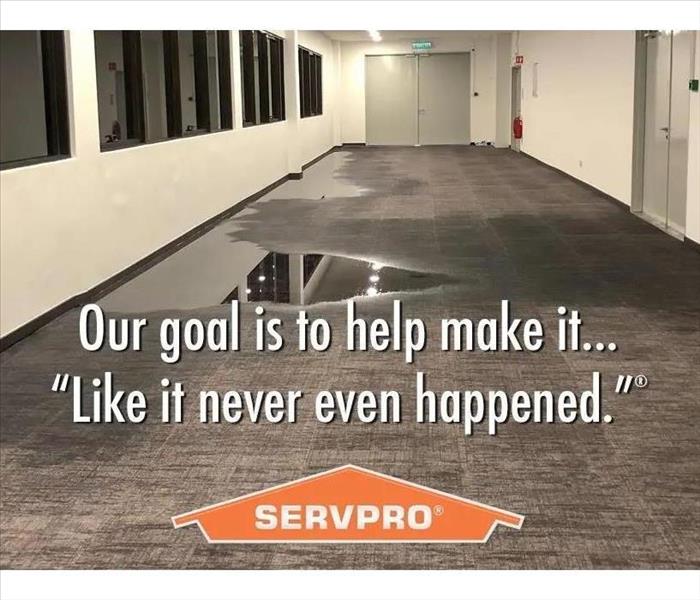
During a heavy rain storm event, a local flower shop basement was flooded with sewage when the storm sewer overflowed into the sanitary sewer and came up the basement shower. SERVPRO of Manistee, Ludington and Cadillac was called to this large basement storage area filled with stock and seasonal items normally sold upstairs. Because raw sewage filled the basement, all porous materials had to be photographed, inventoried, and (if necessary) properly disposed of under sanitary sewage rules. The entire basement had to be mucked out, hot water rinsed and extracted, steam cleaned and disinfected with a SERVPRO proprietary anti-microbial. All non-porous materials on the floor needed to be cleaned and raised on pallets to allow the floor and shelving to be professionally dried. After drying equipment was set and the building dried, the contents were reset. Due to the large amount of stock this was a very large loss and took several days to complete. Our goal is always getting our customers back in business as quickly as possible. If you have a loss, no matter how large, be assured that the experts at SERVPRO of Manistee, Ludington, and Cadillac, can make it "Like it never even happened." Call us at 877-350-4872.
What happens if a storm damages your home and you are put on a waiting list?
11/10/2021 (Permalink)
It happens. During the last big micro event in west Michigan we had over 75 claims filed during the first 48 hours. While not ideal, please don't panic. Usually it takes a day or two for the water to completely stop coming in from the floods and help is coming. SERVPRO of Manistee, Ludington, and Cadillac continued to take leads and contact information around the clock. Our three truck mounts and 5 crews were dispatched as quickly as possible. We immediately notified the other SERVPROs in Western Michigan and asked for additional crews. We bunched the jobs by area and sent the first group of Baldwin jobs to the SERVPRO of Mount Pleasant, Clare & Houghton Lake. We did the same thing for Northern Manistee County to the SERVPRO of Big Rapids and sent leads for Mason County jobs to SERVPRO of NE Grand Rapids. Fortunately the Cadillac and Wellston areas were unaffected.
Other SERVPROs in Gaylord and Muskegon also volunteered to send crews if needed. By the end of the week all customers had been helped. When the out of town SERVPROs finished their leads, we sent them 5 more jobs until the list was empty. While being put on a waiting list can be scary, the experts at SERVPRO of Manistee, Ludington and Cadillac can help. Give us a call at 877-350-4872 to start making it “Like it never even happened."
SERVPRO, the team of professionals you can count to help during a disaster.
9/20/2021 (Permalink)
During last winters deep freeze and subsequent power outages in Texas, nearly 400 SERVPRO’s traveled to help the local franchises. This quick action prevented literally millions of dollars in additional damages caused by mold and secondary damages. Even before the power was restored, SERVPRO's from all over the country (even a crew from Hawaii) arrived in Texas and started demolition of the wet materials and provided generators for power to restore heat and begin the drying process. Don’t wait for a national or state disaster to be declared, call SERVPRO of Manistee, Ludington, and Cadillac at 877-350-4872 and get a team of professionals headed for your home or business. We are always here to help make it "Like it never even happened."
SERVPRO is your local and national restoration company for storms and disasters.
9/15/2021 (Permalink)
SERVPRO of Manistee, Ludington, and Cadillac is part of the national storm team and can respond anywhere we are needed. If the disaster is local, we can also request help from local SERVPRO’s across the state. During last summers micro-event which dropped the all-time state record for rain in a 24 hour period across Mason and Manistee counties, we had help from SERVPRO’s from Clare, Grand Rapids, Big Rapids and Muskegon. The allowed us to “paint the local counties Green” and get our customers lives and homes back within days. This is something no mom and pop restoration company can match. If you have a disaster, give SERVPRO of Manistee, Ludington and Cadillac a call at 877-350-4872. Always here to help.
Advantages of using SERVPRO storm team
9/9/2021 (Permalink)
There are many advantages of using SERVPRO "Storm" versus local contractors. Every day across the United States, SERVPRO’s are traveling for storm events. These may be localized micro storms which drop 12 inches or more of rain in a county sized area, wildfires, tornadoes, hurricanes, floods, or manmade events such as 911, chemical plant explosions, or other unnatural events. Whatever causes the event, it often overwhelms the local SERVPRO’s ability to quickly help all the affected customers. This is where the national storm teams step in to make it "Like it never even happened." If this happens to you, your first call should be to your local SERVPRO of Manistee, Ludington, and Cadillac at 877-350-4872. We are always here to help.
No matter how large, SERVPRO is here to help
4/6/2021 (Permalink)
Late this winter, SERVPRO of Manistee, Ludington, and Cadillac was slammed with several major fires in western Michigan. Because few temporary workers were available, we requested and received crews from our sister SERVPRO's in Mt. Pleasant and Grand Rapids. These franchises sent multiple crews to our area, working 12 hour days and weekends. Along with the highly trained local SERVPRO cleaning technicians, we were able to complete the jobs and help get the homeowners one step closer to moving back into their homes. Then the 2021 version of the Polar Vortex, followed by the power mismanagement, caused heat outages and frozen pipes in most of Texas.
These same franchises then needed to send their crews down south to help put peoples lives back together. Unfortunately, this left Clare and Grand Rapids short handed in Michigan. No problem, SERVPRO of Manistee, Ludington, and Cadillac helped out by sending our crews to their local jobs to help them keep up. This is one of the biggest benefits of the SERVPRO Franchise system. It doesn't matter who is overwhelmed, another franchise will send workers with little or no notice, because we are all after the same goal, getting our customers back in their homes as quickly as possible. If you have a loss, no matter how large, be assured that the experts at SERVPRO of Manistee, Ludington, and Cadillac, with the help of our friends if needed, can make it "Like it never even happened." Call us at 877-350-4872.
Ready for winter weather?
1/15/2021 (Permalink)
SERVPRO of Manistee, Ludington, and Cadillac has been helping customers in Mason, Manistee, Lake, Oceana, Wexford, and Osceola counties survive winter in west Michigan for nearly 20 years. Because the list of things that goes wrong never really changes, SERVPRO would like to remind you of things to check to prevent having to call us for help.
If you have a seasonal home that you are closing for winter and leaving the heat on:
- Have you checked your propane tank and arranged to have it kept full?
- Have you arranged to have the road plowed so the propane company can get to your tank?
- Have you marked your driveway for the plow driver and marked your drain field, sprinkler heads, outdoor hydrants and other potential issues?
- Do you have someone locally who can check on the home? They need to check for open doors and windows, suspicious tracks, heavy snow build up, and fogged or frosted up windows indicating water damage or heat loss.
- Do they have a key or know where it is hidden?
- Have you removed the outside hoses and made sure the frost free shut off valve is clear
- Have you notified the local authorities that you will be gone? They are happy to check on your home for you if you let them know.
- Have you changed the thermostat battery? It is a leading cause of furnace failure in unoccupied homes.
- Consider turning the water off at the well. (Unless you have a boiler that requires make up water) Even if a line freezes, it will not flood your home.
- Open doors to cabinets and vanities that contain water lines to allow heat to circulate.
Have you winterized the home if you are going to turn the heat off?
- If you drain your water heater, remember to turn the power off first to prevent burning out the heating element.
- Have you checked with your insurance company to verify that you still have coverage even if you are not living at the home? (Note: some insurance companies do not insure vacant homes)
- Never leave a temporary heater running in an unoccupied home. They start countless fires every year.
Even though you try to do everything right to prevent a loss, accidents still happen. If you have a loss don’t hesitate to call the local professionals at SERVPRO. Our crews at the Scottville, Manistee, and Cadillac shops can quickly respond to your emergency and help you make it “Like it never even happened.” Give us a call at 877-350-4872 and we will get a crew to your home within an hour.
Generator safety
9/9/2020 (Permalink)
Once again it’s hurricane season in the southern United States. Luckily western Michigan doesn’t get hurricanes but we do get storms that can knock out power for several days at a time. When this happens people often turn to generators. The news from the gulf coast last week says that Hurricane Laura killed more people from carbon monoxide poisoning from generators than died from the storm. This is sad since it is totally preventable.
Although using power generators is useful and often necessary to prevent food spoilage, provide lights, and water, it must be done safely. Never use a generator inside a building or partly enclosed area such as a garage or covered deck. Keep generators away from open windows and doors. Wind can force the exhaust back into your home. Keep generators dry and out of the rain and be careful how you cover them. Try to keep them at least 5 feet from any combustible materials (including tarps).
Never start or stop a generator without first unplugging all cords and making sure there is no load on the unit. Use proper fuel, never leave them unattended, and keep children away from the units. Make sure you don’t overload the generator, do use heavy duty (outdoor rated) extension cords, and let the unit cool completely before adding fuel. Store fuel away from generator if possible.
Carbon monoxide gas is colorless and odorless. You will not even know it is there until it is too late. The experts at SERVPRO of Manistee, Ludington, and Cadillac can help with the storm damage, but the only thing we can do about generator safety is to remind you to be careful. Call our crews located at our offices in Ludington, Manistee, and Cadillac at 877-350-4872 for 24 hour help.
When a storm hits, how safe is the water in your basement or crawlspace?
3/17/2020 (Permalink)
When a storm drops a foot of rain you quickly find out your homes weak areas. It may be the roof or gutter system, or skylights, or possibly the foundation or sump pump. Because of the laws of gravity, eventually the problem will end up in your basement or crawlspace. When this happens, you must be very careful how you deal with the water. Aside from the obvious issues with electricity and water there can be another problem; the water may be contaminated.
The IICRC and the EPA standards state that all groundwater is considered Category 3 which “is grossly contaminated and can contain pathogenic toxigenic or other harmful agents and can cause significant adverse reactions to humans if contacted or consumed. Examples of Category 3 water can include, but are not limited to: sewage; waste line backflows that originate from beyond any trap regardless of visible content or color; all forms of flooding from seawater; rising water from rivers and streams; and other contaminated water entering or affecting the indoor environment, such as wind-driven rain from hurricanes, tropical storms, or other weather-related events.” This water and everything it touches can make you sick.
Making matters worse is you probably have limited or no coverage help from your insurance company. The experts at SERVPRO of Manistee, Ludington, and Cadillac can help you understand what steps you need to take to protect your home and family. As a general rule, hard surfaces can be cleaned and disinfected while porous surface items should be discarded. This includes carpeting and pad, wet drywall and insulation, and affected clothing and bedding. And of course, the sooner you call, the higher on the waiting list your name will be. So don’t wait. Call SERVPRO of Manistee, Ludington and Cadillac, we are always here to help.
What to do when you have a loss and get placed on a waiting list.
2/22/2020 (Permalink)
When a storm event hits your home or community it can be devastating. To make matters worse you may not be able to get help quickly. There is nothing worse than having a loss and being put on a waiting list. This is where SERVPRO of Manistee, Ludington, and Cadillac can help. While a storm event is usually local, it still may affect hundreds of homes. Most restoration companies can handle only 2-3 losses a day and put the rest on a waiting list. SERVPRO has over one hundred sister franchises in Michigan that can scramble crews to any event. Whether the problem is wind, rain, flooding, or even a polar vortex SERVPRO of Manistee, Ludington and Cadillac can help make it "Like it never even happened."
“Storm” in West Michigan
2/4/2020 (Permalink)
When the restoration industry thinks "Storm", it usually means tropical storms or hurricanes in the Gulf or the Southeast. When these major events happen, SERVPROs from all over the country pack up and head to the impacted area to help make it "Like it never even happened.” This is one of the advantages of being the world's largest disaster restoration company. No matter how large the event, SERVPRO can cover it.
Luckily Michigan does not usually get these life threatening and expensive storms.
In Michigan, “Storm” means tornadoes, straight line winds, and/or micro bursts of rain. Last summer Manistee and Mason counties were hit with over 12 inches of rain in one 24 hour period---a new state record. While it is nice to hold a state record, it wasn't nearly that much fun when you watched your basement or cabin fill with water. Our shop in Manistee received over 100 calls for help per day over the last weekend of July.
With 3 truck mounted extractors and multiple crews we were able to help many of the residents. However, we soon realized that we would not be able to help all the customers in a timely manner. We reached for the phone and called our sister franchises in Traverse City, Mount Pleasant/Clare, Big Rapids, Muskegon, and Grand Rapids. Most immediately sent trucks and crews and by Sunday morning there were multiple green trucks helping people in every affected city in our territory. These crews stayed throughout the week until all our customers were taken of and had their homes back.
Another storm event that recently hit our coverage area was the tornado that hit Mason and Lake Counties. This EF2 tornado and the associated straight line winds centered in Baldwin, toppled thousands of trees and destroyed countless roofs. While SERVPRO does not do roof repairs or tree removal from roofs, we do have a long list of professionals who can help. When the calls started coming in, we were able to bypass the normal waiting lists and get people in contact with crews who could quickly get the trees off the roofs and driveways opened.
Once the trees are off the roofs, SERVPRO of Manistee, Ludington, and Cadillac can get the roofs tarped and windows boarded up and start the drying process. Unfortunately, lack of power is usually an issue and can delay drying. If the home sustains structural damage from the wind or trees, sometimes we will need to pack out the contents to one of our climate controlled storage units while repairs are made. These repairs and content removal and storage are almost always covered by normal homeowners insurance. While “Storm” events are never fun, SERVPRO of Manistee, Ludington, and Cadillac can help you get your home back to "Like it never even happened."
Another 100 Year Flood in Western Michigan
9/2/2019 (Permalink)
SERVPRO of Manistee, Ludington, and Cadillac and our sister franchises from Clare, Muskegon, Traverse City, and Big Rapids helped over 100 homes who suffered water damage from the late July storm that hit western Michigan. Hardest hit was Manistee, Ludington, Scottville, Free Soil, Fountain, Wellston, Irons, Baldwin, Wolf Lake, Custer, Dublin, Bear Lake, and Onekama who recently received over a foot of rain in one day. As rivers overflowed and city storm sewers were overwhelmed, our customers saw the water rise in their basements and crawlspaces.
They call this a 100 year flood. But what does that mean? A 100 year rain does not mean you can expect to get a rain of that size every one hundred years. It actually means that in any given year, you have a 1% chance of getting a foot of rain from one storm. A 50 year storm has a 2% chance and a 25 year storm has a 4% chance in any given year.
You can go to the FEMA FLood Map Service Center https://msc.fema.gov/portal/home and check out the probability of your home getting flooded (if your area was mapped and most are). The higher the risk of flooding, the more you should consider buying flood insurance from FEMA. As most of West Michigan knows by now, your home policy probably will not cover a water event coming from outside the structure. Sometimes limited coverage ($2,000-5,000) can be purchased through your homeowner’s policy as a sump pump or sewage back up failure rider, but most home policies specifically exclude groundwater or water coming from outside the home.
You can also check to see if your community participates in the National Flood Insurance Program (NFIP). Remember there is usually a 30-day waiting for this type of insurance to kick in so don’t wait until your phone announces a flood warning to call your insurance company. You should also talk to your local insurance agent. They are the experts and know what is available in your area. Many of them sell enhanced policies that cover some types of water intrusion (hydro-static intrusion, sump pump failure, or septic backups). They can also help walk you through the steps to get on a federal program to give you some protection from the 100 year rains that seem to be coming much more frequently.
FEMA’s statistics show that over 20 percent of flood insurance claims are for non-high risk zones. Whether climate change is temporary or permanent doesn’t really matter to your wet basement. Large storms and weather events are clearly happening more frequently and you need to be prepared. Some of the things you can do will help with even normal rainfall amounts. Install and maintain roof gutters with downspouts to get the water at least 6 feet away from your foundation. Consider landscaping to drain the water away from your home. Clean out ditches and culverts on your property or call the local road commissions for help. Work with your neighbors on larger projects (their basement is probably wet also).
Because flood insurance from the NFIP program usually has limited or no coverage for below ground areas (basements and crawlspaces) and the contents stored in them be careful what you store down there. Now may be the time to get rid of the college furniture your son has stored in your basement and get some plastic totes for the craft supplies that are in cardboard boxes on the floor. If you haven’t used that exercise bike in 10 years you may want to find someone who would it to take up space in his basement.
Other items not typically covered are paper documents and money or valuables stored in the basement. Outdoor decks, patios, fences, hot tubs and pools, outdoor furniture, and wells and septic systems are typically excluded. Usually this insurance will not cover temporary housing or living expenses. You may have coverage for some of these items (and possibly large appliances like washer and dryer or furnace) through your home insurance under a personal contents cover.
Your friends at SERVPRO of Manistee, Ludington, and Cadillac hope you never have to use our water damage and restoration services but knowing your options before the loss should make dealing with the event easier. Please call your local insurance agent for more details if you have questions as every area is different. If you do get hit with a 100 year flood, call the professionals at SERVPRO and we will do our best to make it "Like it never even happened.”
Baby It's Cold Outside
2/6/2019 (Permalink)
With the below zero temperatures and wind chills these past weekends, SERVPRO of Manistee, Ludington, and Cadillac has received multiple calls for frozen and burst water pipes. As you know, it is easier to prevent these things than to fix them so here are a few tips from your friends at SERVPRO.
Pay attention to the wind direction. A cold north wind will drive the cold through the north facing walls of your home much faster than the same temperatures with no wind. If you have pipes in the walls facing the wind direction pay close attention to them. Consider opening the base cabinet’s doors to allow warmer room air to reach your pipes. Inspect the insulation or heat wraps carefully for openings or damage in areas prone to freezing.
Running a small stream of water can also help prevent freezing particularly if you are on city sewer lines. You must be very careful running water if you have a septic tank however. You cannot run more water into a septic tank than can drain away through the drain field without it backing up and causing major problems. Add no snow cover, which means frozen ground, and the potential for backups becomes much greater. Running water for a few hours a day or a small stream will probably not cause any issues, but a large stream for a long time can cause problems.
Do you have a well pit outside? Many older homes still do and with the lack of snow cover to insulate the pits, they can freeze. Consider some dry straw covered with a tarp (wet stray has no insulation properties). A simple light bulb will often provide enough heat to solve the freezing problems. Hint: check the light regularly to insure it is still functioning. Remember to remove the hose from the frost free hose bib on your home to allow it to drain and prevent it from freezing and flooding your basement.
Some of the old school energy hints are very effective on helping keep your home warm and saving money. Clear plastic on the windows will prevent drafts and keep the room much warmer. If you have curtains and window dressing, keep them closed when it is really cold outside and the sun is not shining. (Think Michigan in winter) Close off unused rooms especially if there are no water lines in the room. Seal drafts with caulk, rugs, or weather stripping.
If you do have a frozen pipe, thaw it with a hair drier or some non-combustible heat source. Many fires are started every year with homeowners trying to thaw pipes with space heaters, torches, or other improper heat sources. If you must leave the home with frozen pipes remember to shut off the water supply in case the line thaws or bursts flooding the home. These really can be “do it yourself” fixes but be careful that you don’t cause larger problems.
Floods
2/21/2018 (Permalink)
Flooding is one of the most common and widespread natural disasters in America. Fema has reported that in the last 5 years, every state in the United States has experienced floods or flash flooding. 20% of all flood insurance claims come from a low to moderate risk area.
According to the American Red Cross, flooding causes more damage in the United States than any other natural disaster that is weather related. On average, a home that has 1 inch of flood damage can cost about $27,000.
In the event that a flood strikes your home or business, SERVPRO of Manistee, Ludington and Cadillac is here to help. With 24 hour 7 day a week service, we will have you back in your home or business in no time.
Using a generator safely following Michigan storms
3/16/2017 (Permalink)
Yesterday's paper read, "Two Die At Home Running Generator During Power Outage." In this case, an elderly couple died after setting the generator in an enclosed garage because of the power outage. Their death was entirely preventable. The U.S. Consumer Product Safety Commission requires manufactures of portable generators to have a label that states "DANGER! Using a generator indoors CAN KILL YOU IN MINUTES."
* Never use generators indoors.
*Never set generator outdoors near a window, door or vent.
* Never use generators in crawlspaces or under awnings.
* To prevent shock and electrocution, never use a generator in wet conditions.
* Make sure you have working CO (Carbon Monoxide) detectors and alarms in your home.
Opening doors and windows will not prevent carbon monoxide buildup, although, you cannot see or smell carbon monoxide. Symptoms include feeling sick, dizzy or weak. If you hear a generator running in your neighborhood, please check to see if it is being operated properly. If you suspect CO poisoning, do not open the building. Call 911 or your local fire department immediately for professional assistance. Carbon Monoxide deaths are easily preventable and SERVPRO of Manistee, Ludington and Cadillac, encourages you to use generators safely and watch out for your neighbors and friends!






 24/7 Emergency Service
24/7 Emergency Service
